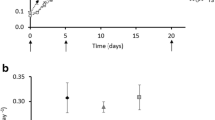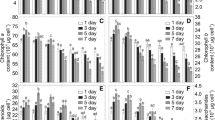Abstract
Heavy metal pollution has become a worldwide problem in aquaculture. We studied copper (Cu2+) accumulation and physiological responses of two red algae Gracilaria lemaneiformis and Gracilaria lichenoides from China under Cu2+ exposure of 0–500 μg/L in concentration. Compared with G. lemaneiformis, G. lichenoides was more capable in accumulating Cu2+, specifically, more Cu2+ on extracellular side (cell wall) than on intracellular side (cytoplasm) and in cell organelles (especially chloroplast, cell nucleus, mitochondria, and ribosome). In addition, G. lichenoides contained more insoluble polysaccharide in cell wall, which might promote the extracellular Cu2+-binding as an efficient barrier against metal toxicity. Conversely, G. lemaneiformis was more vulnerable than G. lichenoides to Cu2+ toxin for decreases in growth, pigment (chlorophyll a, chlorophyll b, phycobiliprotein, and β-carotene) content, and photosynthetic activity. Moreover, more serious oxidative damages in G. lemaneiformis than in G. lichenoides, in accumulation of reactive oxidative species and malondialdehyde, and in electrolyte leakage, because of lower antioxidant enzyme (superoxide dismutase and glutathione reductase) activities. Therefore, G. lichenoides was less susceptible to Cu2+ stress than G. lemaneiformis.
Similar content being viewed by others
References
Andrade L R, Leal R N, Noseda M, Duarte M E, Pereira M S, Mourão P A, Farina M, Amado Filho G M. 2010. Brown algae overproduce cell wall polysaccharides as a protection mechanism against the heavy metal toxicity. Marine Pollution Bulletin, 60(9): 1 482–1 488.
Ata A, Nalcaci O O, Ovez B. 2012. Macro algae Gracilaria verrucosa as a biosorbent: A study of sorption mechanisms. Algal Research, 1(2): 194–204.
Axelsson B, Axelsson L. 1987. A rapid and reliable method to quantify environmental effects on Laminaria based on measurements of ion leakage. Bot. Mar., 30: 55–61.
Bolhar-Nordenkampf H R, Long S P, Baker N R, Oquist G, Schreiber U, Lechner E G. 1989. Chlorophyll fluorescence as a probe of the photosynthetic competence of leaves in the field: a review of current instrumentation. Funct. Ecol. 3: 497–514.
Boyd C E, Massaut L. 1999. Risk associated with the use of chemicals in pond aquaculture. Aquac. Eng., 20: 113–132.
Brooks R R, Shaw S, Marfil A A. 1981. The chemical form and physiological function of nickel in some Iberian Alyssum species. Physiol. Plant, 51: 167–170.
Brown M T, Newman J E. 2003. Physiological responses of Gracilariopsis longissima (S. G. Gmelin) Steentoft L M Irvine and Farham (Rhodophyceae) to sub-lethal copper concentrations. Aquat. Toxicol., 64: 201–213.
Collén J, Pinto E, Pedersén M et al. 2003. Induction of oxidative stress in the red macroalga Gracilaria tenuistipitata by pollutant metals. Arch. Environ. Contam. Toxicol., 45: 337–342.
Cotou E, Henry M, Zeri C et al. 2012. Short-term exposure of the European sea bass Dicentrarchus labrax to copperbased antifouling treated nets: copper bioavailability and biomarkers responses. Chemosphere, 89(9): 1 091–1 097.
Evans L V. 1981. Marine algae and fouling: a review, with particular reference to ship-fouling. Bot. Mar. 24: 167–171.
Fang R. 1991. Application of Atomic Absorption Spectroscopy in Sanitary Test. Beijing University Press, Beijing. p.148–158.
Farias W R, Valente A P, Pereira M S et al. 2000. Structure and anticoagulant activity of sulfated galactans. J. Biol. Chem., 275: 29 299–29 307.
Giannopolitis C N, Ries S K. 1977. Superoxide dismutase occurrence in higher plants. Plant Physiol., 59: 304–314.
Haglund K, Björklund M, Gunnare S et al. 1996. New method for toxicity assessment in marine and brackish environments using the macroalga Gracilaria tenuistipitata (Gracilariales, Rhodophyta). Hydrobiologia, 326: 317–325.
Han T J, Kang S H, Park J S et al. 2008. Physiological responses of Ulva pertusa and U. armoricana to copper exposure. Aquatic Toxicology, 86: 176–184.
Hashim M A, Chu K H. 2004. Biosorption of cadmium by brown, green, and red seaweeds. Chem. Eng. J., 97: 249–255.
Huo Y Z, Xu S N, Wang Y Y et al. 2011. Bioremediation efficiencies of Gracilaria verrucosa cultivated in an enclosed sea area of Hangzhou Bay, China. J. Appl. Phycol., 23:173–182.
Huo Y Z, Xu S N, Wang Y Y et al. 2012. Bioremediation efficiency of Gracilaria verrucosa for an integrated multitrophic aquaculture system with Pseudosciaena crocea in Xiangshan harbor, China. Aquaculture, 329: 99–105.
Jimenez A, Hernandez J A, del Rio L A et al. 1997. Evidence for the presence of ascorbate-glutathione cycle in mitochondria and peroxisomes of pea leaves. Plant Physiol., 114: 275–284.
Kaladharan P, Vijayakumaran K, Chennubhotla V S K. 1996. Optimization of certain physical parameters for the mariculture of Gracilaria edulis (Gmelin) Silva in Minicoy lagoon (Laccadive Archipelago). Aquaculture, 139: 265–270.
Küpper H, Šetlík I, Spiller M et al. 2002. Heavy metal induced inhibition of photosynthesis: targets of in vivo heavy metal chlorophyll formation. J. Phycol., 38: 429–441.
Kursar T A, van der Meer J P, Alberte R S. 1983. Lightharvesting system of the red alga Gracilaria tekvahiae. I. Biochemical analysis of pigment mutations. Plant Physiology, 73: 353–360.
Lei Y, Korpelainen H, Li C. 2007. Physiological and biochemical responses to high Mn concentrations in two contrasting Populus cathayana populations. Chemosphere, 68: 686–694.
Lewis A G, Metaxas A. 1991. Concentrations of total dissolved copper in and near a copper-treated salmon net pen. Aquaculture, 99: 269–276.
Macfie S M, Welbourn P M. 2000. The cell wall as a barrier to uptake of metal ions in the unicellular green alga Chlamydomonas reinhardtii (Chlorophyceae). Arch. Environ. Contam. Toxicol., 39: 413–419.
Mal T K, Adorjan P, Gorbett A L. 2002. Effect of copper on growth of an aquatic macrophyte Elodea Canadensis. Environ. Pollut., 120: 307–311.
Martins C, Barcarolli I F, Menezes E J et al. 2011. Acute toxicity, accumulation and tissue distribution of copper in the blue crab Callinectes sapidus acclimated to different salinities: in vivo and in vitro studies. Aquatic Toxicology, 101(1): 88–99.
Maxwell K, Johnson G N. 2000. Chlorophyll fluorescence a practical guide. J. Exp. Bot., 51: 659–668.
Nakano Y, Asada K. 1981. Hydrogen peroxide is scavenged by ascorbate-specific peroxidase in spinach chloroplast. Plant Cell Physiol., 22: 76–80.
Prasad M N V, Malec P, Waloszek A et al. 2001. Physiological responses of Lemna trisulca L. (duckweed) to cadmium and copper bioaccumulation, Plant Sci., 161: 881–889.
Schreiber U, Schliwa U, Bilger W. 1986. Continuous recording of photochemical and non-photochemical chlorophyll fluorescence quenching with a new modulation fluorometer. Photosynth. Res., 10: 51–62.
Sgherri C L M, Loggini B, Puliga S et al. 1994. Antioxidant defense system in Sporobolus stapfianus: changes in response to dessication and rehydration. Phytochemistry, 33: 561–565.
Stauber J L, Florence T M. 1987. Mechanism of toxicity of ionic copper and copper complexes to algae. Mar. Biol., 94: 511–519.
Stengel D B, Macken A, Morrison L et al. 2004. Zinc concentrations in marine macroalgae and lichen from western Ireland in relation to phylogenetic grouping, habitat and morphology. Mar. Poll. Bull., 48: 902–909.
Sudhakar C, Lakshmi A, Giridarakumar S. 2001. Changes in the antioxidant enzymes efficacy in two high yielding genotypes of mulberry (Morusalba L.) under NaCl salinity. Plant Sci., 161: 613–9.
Tang K X, Yuan D X, Lin S B et al. 2003. Depression and affect of red tide on main water quality index by Gracilaria tenuistipitata. Mar. Environ. Sci., 22: 24–27.
Tanyolac D, Ekmekci Y, Ünalan S. 2007. Changes in photochemical and antioxidant enzyme activities in maize (Zea mays L.) leaves exposed to excess copper. Chemosphere, 67: 89–98.
Van-Heerden P D R, Robertson B L, De-Kock L. 1997. Inhibition of Ectocarpus siliculosus infestations with copper chloride in tank cultures of Gracilaria gracilis. J. Appl. Phycol., 9: 255–259.
Virginia G R, Yolanda F P, Daniel R et al. 2007. Cell wall composition affects Cd2+ accumulation and intracellular thiol peptides in marine red algae. Aquatic Toxicology, 81: 65–72.
Wellburn A R. 1994. The spectral determination of chlorophylls a and b, as well as total carotenoids, using various solvents with spectrophotometers of different resolution. J. Plant Physiol., 144: 307–313.
Xu Y J, Fang J G, Wei W. 2008. Application of Gracilaria lichenoides (Rhodophyta) for alleviating excess nutrients in aquaculture. Journal of Applied Phycology, 20: 199–203.
Yang Y F, Fei X G, Song J M et al. 2006. Growth of Gracilaria lemaneiformis under different cultivation conditions and its effects on nutrient removal in Chinese coastal waters. Aquaculture, 254: 248–255.
Yu J Q, Zhou Y H, Huang L F et al. 2002. Chill-induced inhibition of photosynthesis: genotypic variation within Cucumis sativus. Plant Cell Physiol., 43: 1 182–1 188.
Yun Y S, Park D, Park J M et al. 2001. Biosorption of trivalent chromium on the brown seaweed biomass. Environ. Sci. Technol., 35(21): 4 353–4 358.
Zhou Y, Yang H S, Hu H Y et al. 2006. Bioremediation potential of the macroalga Gracilaria lemaneiformis (Rhodophyta) integrated into fed fish culture in coastal waters of north China. Aquaculture, 252: 264–276.
Author information
Authors and Affiliations
Corresponding author
Additional information
Supported by the Society Development Program of the Natural Science Foundation of Jiangsu Province in China (No. BS2002016)
Rights and permissions
About this article
Cite this article
Huang, H., Liang, J., Wu, X. et al. Comparison in copper accumulation and physiological responses of Gracilaria lemaneiformis and G. lichenoides (Rhodophyceae). Chin. J. Ocean. Limnol. 31, 803–812 (2013). https://doi.org/10.1007/s00343-013-2261-5
Received:
Accepted:
Published:
Issue Date:
DOI: https://doi.org/10.1007/s00343-013-2261-5




